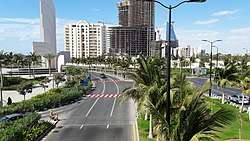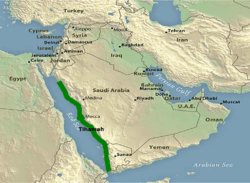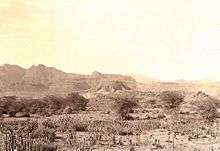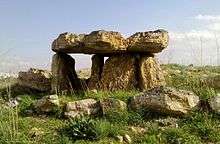Tihamah
Tihamah or Tihama (Arabic: تِهَامَةُ Tihāmah) refers to the Red Sea coastal plain of the Arabian Peninsula from the Gulf of Aqaba to the Bab el Mandeb.[1]
Tihamah تِهَامَةُ Tihāmah | |
|---|---|
 | |
 | |
| Region | Arabian Peninsula |
| Countries | Saudi Arabia Yemen |
| Cities | Yanbu, Al Qunfudhah, Jizan and Al Hudaydah |
Etymology
Tihāmat is the Proto-Semitic language's term for 'sea'. Tiamat (or Tehom, in masculine form) was the ancient Canaanite god of the sea and of chaos. The word appears in the Hebrew creation myth as təhōm (Genesis 1:2), meaning "primordial ocean, abyss".[2]
History
Era of Muhammad
During the era of the Islamic Nabi (Prophet) Muhammad, many military expeditions took place here including the Battle of Hamra al-Asad and caravan raids. Beginning in January 623 CE, some of the Muslims resorted to the tradition of raiding the Meccan caravans that traveled along the eastern coast of the Red Sea from Mecca to the Syrian region.[3] Communal life was essential for survival in desert conditions, as people needed support against the harsh environment and lifestyle. The tribal grouping was thus encouraged by the need to act as a unit. This unity was based on the bond of blood kinship that granted regional tribes a common heritage with each other.[4] Peoples of Arabian Peninsula were either nomadic or sedentary, the former constantly travelling from one place to another seeking water and pasture for their flocks, while the latter settled and focused on trade and agriculture. The survival of nomads (or Bedouins) was also partially dependent on raiding caravans or oases, thus they saw this as no crime.[5]
While at Ḥamra' al-Asad (حَمْرَاء ٱلْأَسَد), Muhammad made an agreement with Mabad al-Khuzaah at Tihamah, in which Mabad pledged not to conceal anything from him. Mabad was then sent to Mecca to dissuade Abu Sufyan ibn Harb from fighting.[6]:341 In Mecca, Mabad met with Abu Sufyan and exaggerated that Muhammad had gathered a great force to fight Abu Sufyan. Abu Sufyan and his companions were planning a massive and decisive attack on Medina to finish off the Muslims once and for all. Hearing Mabad's talk of the great military strength of Muhammad, Abu Sufyan retreated from his plan of an immediate attack on the Muslims. In this fashion Muhammad successfully managed to prevent the massive onslaught the Meccans were planning.[7][6]:342
Geography

The region is sometimes subdivided into two parts, Tihāmat Al-Ḥijaz (تِهَامَة ٱلْحِجَاز; northern part) and Tihāmat ʿAsīr (تِهَامَة عَسِيْر; southern part).[1] The Yemeni part (Arabic: تِهَامَة ٱلْيَمَن, romanized: Tihāmat Al-Yaman) is an extension of Tihamat ʿAsir.[8] The plain is constricted and attains its greatest widths (60 to 80 km (37 to 50 mi)) south of Medina and Mecca.[1] The cities of Yanbu, Jeddah and Al Qunfudhah are located in the Hijazi part of the Tihamah. The Asiri-Yemeni part of the Tihami plain includes the cities of Jizan and Al Hudaydah. The temperatures in Tihamah are probably some of the hottest on earth. Tihamah in Arabic means severe heat and lack of wind.[9]
Flora

The extensive sandy coastal plain (the Tihamah) is a hot and inhospitable area parallel to the Red Sea, and most of it, north of Zabid (Yemen), is devoid of trees. However, in a few places there is dense shrub composed almost exclusively of Acacia ehrenbergiana and it may be assumed that this was originally the dominant natural vegetation of the Tihamah. Salvadora persica occurs in thickets, and there are odd trees of Balanites aegyptiaca and colonies of wild doum palm (Hyphaene thebaica), as well as planted date palms (Phoenix dactylifera).[10]
Archaeology
Over sixteen megalithic menhirs were discovered by Edward Keall, director of the Royal Ontario Museum's Canadian Archaeological Mission near the village of Al-Mutaynah (ٱلْمُتَيْنَة) in the Tihami area. The stones were made of granite and weighted up to 20 tonnes (20,000 kg). Three of the upright stones measured around 8 feet (2.4 m) tall with one fallen being over 20 metres (66 ft) in length. Copper tools suggested to date to the same era as the construction of the stones were dated to around 2400 to 1800 BCE. An even more archaic lithic industry was found along with pottery sherds that were dated between 1200 and 800 BCE.[11]
See also
References
- "Arabia". Encyclopædia Britannica. Retrieved 20 March 2013.
The Red Sea coastal plain is constricted throughout its length, attaining its greatest widths, 40 to 50 miles, south of Medina and south of Mecca. The name Tihāmah, used for the whole plain, is sometimes subdivided into Tihāmat Al-Ḥijāz and Tihāmat ʿAsīr.
- Stefan Weninger, ed. (2011), Semitic languages: an international handbook, Berlin / Boston: Walter de Gruyter GmbH & Co. KG
- Lapidus, Ira M. (2002). A History of Islamic Societies. Cambridge University Press. p. 27. ISBN 978-0-5217-7933-3.
- Watt (1953), pp. 16-18
- Rue, Loyal (2005), Religion Is Not about God: How Spiritual Traditions Nurture Our Biological, p. 224
- Al-Mubarakpuri, Saifur Rahman (2002). The sealed nectar: biography of the Noble Prophet. Darussalam Publications. pp. 341–342. ISBN 978-9960-899-55-8.
- Habriel, Richard A. (2005). Muhammad, Islams first Great general. Blackwell. p. 124. ISBN 978-0-8061-3860-2.
- "Yemen". Encyclopædia Britannica. Retrieved 20 March 2013.
Yemen may be divided into five major regions: a coastal plain running north-south known as the Tihāmah (an extension of the Tihāmat ʿAsīr), the western highlands, the central mountains (the Yemen Highlands), the eastern highlands, and finally the eastern and northeastern desert regions.
- Dr. Shawqi Abu Khalil (2004). Atlas on the prophet's Biography. Darussalam. p. 31. ISBN 9-9608-9771-0. Retrieved 20 March 2013.
It is so called because of its severe heat and lack of wind, from the word At-Taham which refers to extreme heat and lack of wind.
- Hepper, F.N. (July 1978). "Were There Forests in the Yemen?". Proceedings of the Seminar for Arabian Studies. 9 (1979): 65–71. JSTOR 41223217.
- Harrington, Spencer P. M. (December 10, 1997), Yemeni Megaliths, Archaeology, the Archaeological Institute of America
Further reading
- Thesieger, Wilfred (1947). "A Journey Through the Tihama, the 'Asir, and the Hijaz Mountains". The Geographical Journal. The Royal Geographical Society (with the Institute of British Geographers). 110 (4/6): 188–200. doi:10.2307/1789949. JSTOR 1789949.
External links
| Wikimedia Commons has media related to Tihamah. |

